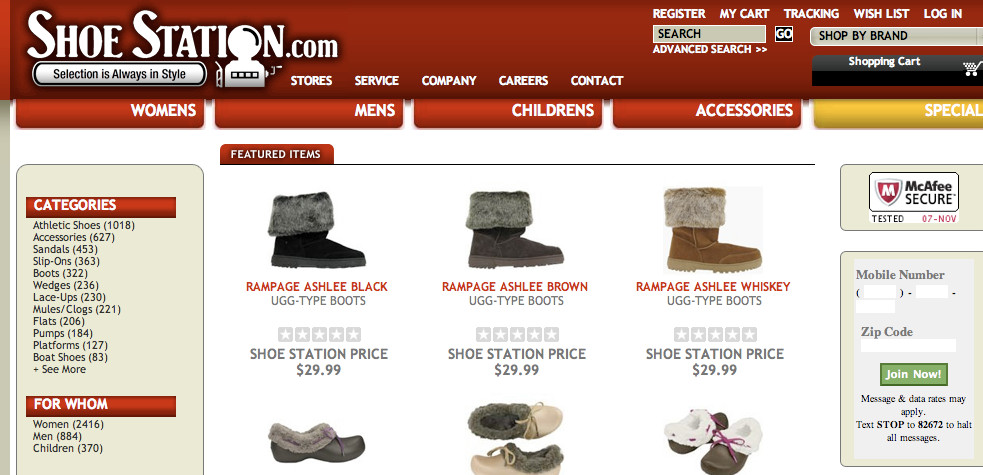Shoe Station leverages local media to build non-traditional marketing
How should local media compete - or exploit - current trends in text-marketing? One of the best ways to gain insight is explore how a significant "mid-tier" local company successfully uses texting with traditional media to generate $3500 a week in new revenues.
Challenge: Shoe Station, whose slogan is "The South's largest shoe stores," operates large, self-service, open-shelf stores in 19 locations throughout five states. Founded in 1984 and based in Mobile, Alabama, the stores are similar to the big box DSW stores on the west coast. Marketing director Bret Barkin originally became interested in text-marketing as a way to promote online shoe sales - the site carries 2416 varieties of women's shoes and 249 varieties of Nike's just for starters.
He quickly found, however, that text-marketing was, in fact, building traditional customers at the brick and mortar stores, and increased traditional media buys to help build opt-in lists.
Strategy: Shoe Station is a significant traditional newspaper advertiser in many of its markets and using an advertising agency to make many of the buys. To build the text-message list, however, Barkin by-passed the ad agency and contracted a local company to provide a texting platform.
Besides full page print ads, Shoe Station utlized a variety of strategies to promote its new text program, including a 100,000 email list. Barkin added in-store and online promotions to ask customers to "text back" to receive discounts and opt-in for future promotions. The full promotional campaign incorporates the following list-buidling strategies:
1. Use of pre-existing newspaper ads
2. Footers on new ads
3. Liners on digital billboards
4. Widgets on front of their own website
5. Mention of text opt-in on a weekly email blast to 100,000 people
6. In-store signage and presence
To leverage its own brick and mortar operations, "text back for a discount" programs were also mentioned on printed receipts and large signs within the 19 stores. A great place to put the signage, Barkin says, is at the store's register where people are able to sign up at the point of sale and can use the discounts there and then. Some of the idividual store cash registers are on different systems, but Barkin says that use of a special product code enabled even unsophisticated POS systems to track results.
Offers used: ShoeStation uses text-only coupons, such as 55% off, that are higher than any other offers. Some texts have included:
•Station Special Text Member coupon! Kid's Soda $5 OFF use code 27442.Valid in stores only thru July 12.
•Through 8/29. Use code 216220 & Get Gift Card for each pr ShapeUps purchased in store.
Not every offer works; the ones that do have a few things in common, Barkin says:
• They are exclusive to the list
• Vary from the standard offers on other ads and promotions
• The offer is highly tailored to the list audience. That is, "do not make an offer valid only on a purchase over $1000 when most people average $40 per visit"
Results: Shoe Station grew the opt-in list to 14,000 customers - about 736 per store - as of September, 2010, and from this list generates an average of $3500 in revenues per text-message. At one message a week, the amount allowed as per IAB best practices, the program yields more than $200,000 in new annual revenues largely from redeploying current resources. (The texting service itself is a relatively insignificant expense). The list is growing at about 2,000 names per month throughout the chain, an average of about 24 names per store, per week.
What’s next? Shoe Palace plans to use additional tools to segment the list and keep the offers relevant. "Right now we have no way to separate men and women" on the list, he says. He plans to use a poll to help segment the existing list to tailor the message, and collect information, say, on customers who might be interested in ski sales and other specific items, and then to adjust the opt-in interfaces so that new customers will also be separated by interest.
Another initiative is gettting vendors involved, but having them supply a GWP, or Gift With Purchase, or to participate in moving merchandies quickly by allowing a larger (group-deal sized) discount and chargeback on the inventory.
Finally, he is interested in using contests and giveaways to grow the list.
"Why do I need media people?" Barkin asks."Some of the best things we have been able to do are because (media, buys) are enabling us to do this. We plan to bring more media on board to push these things."
Conclusion: We think more needs to be done and attention paid to close the gap between what local media sells and what local advertisers value (For an ItzBelden report of local media marketing preferences by vertical or a survey of your market, please email greg@itzbelden; these reports are very reasonably priced and completely worth it). So it is critical for media executives to start learning how advertisers like ShoeStation are utilizing new marketing methods or face a disconnect that can and will result in lost accounts. Here are a number of takeaways for local media companies training sales representatives to approach customers who are interested in, or may become interested in text-messaging services. Consider providing the text-marketing platform to local businesses; there are a number of significant advantages also outlined here.
Many thanks to Bret Barkin for sharing his experiences running Shoe Station's text-marketing program and to Borrell & Associates for bringing him to the Local Mobile Advertising conference.






